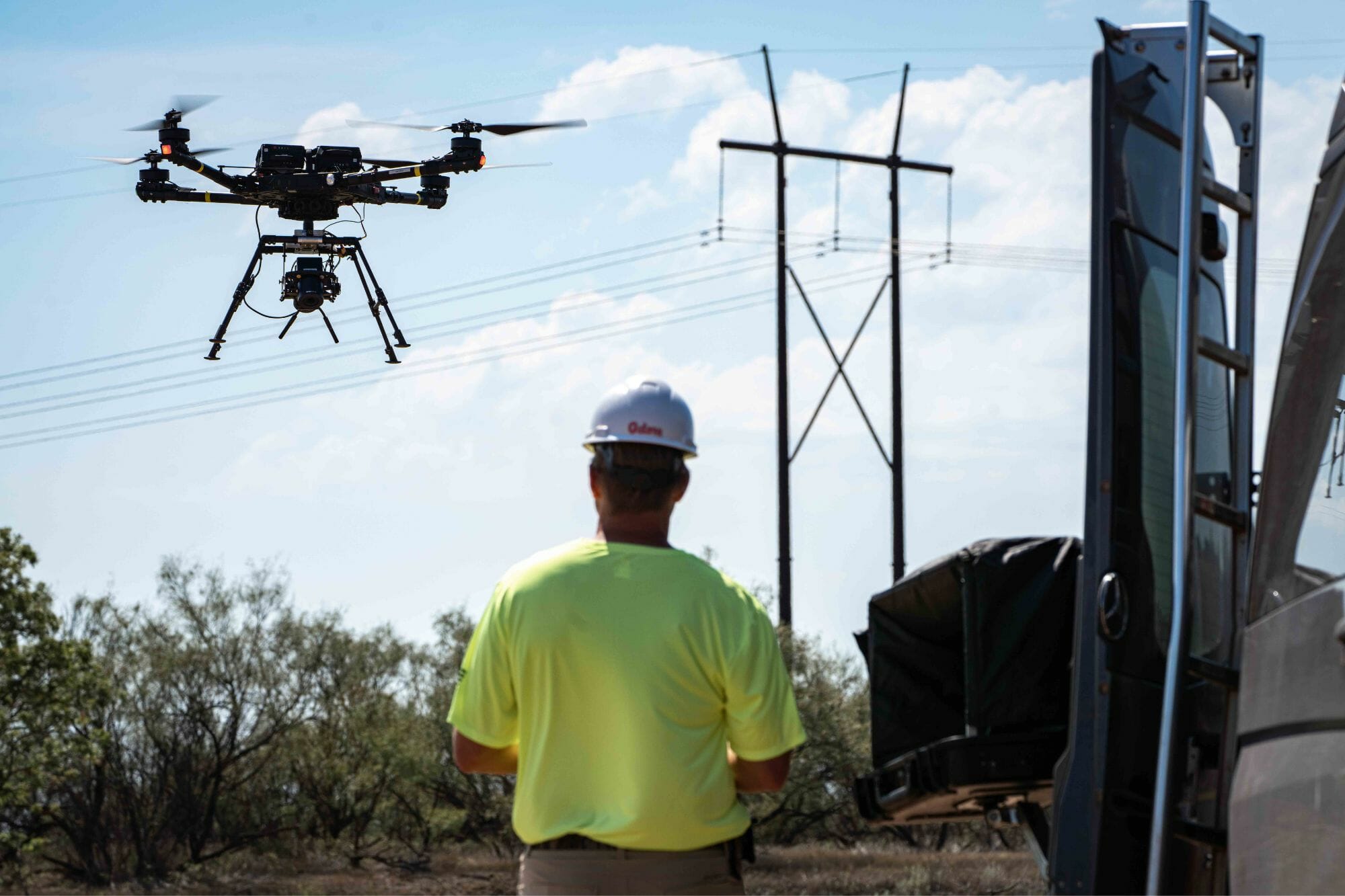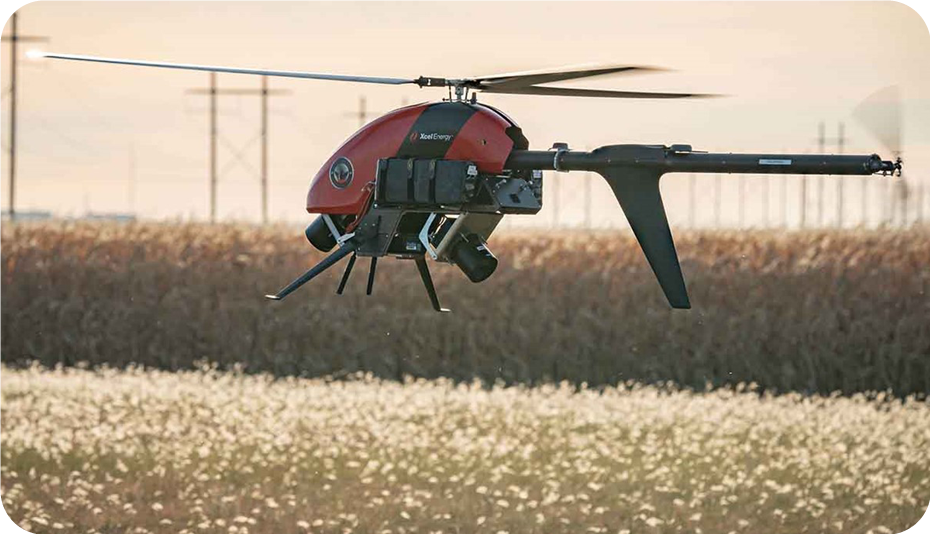In hindsight of the BNEF – The New Energy Outlook: Grids report, it is apparent that large investments across the grid infrastructure are needed to continue on the net-zero trajectory. According to the report, the power grid will double in size by 2050.
We are arriving at the fifth industrial revolution (impressively, the power grid’s implementation spans back to the second!), and it is defined by data. When being described, this is the time of technological advancements, automation, increased operational efficiency and technical assistance. And it is just in time, as these are required for us to be able to build out, maintain and connect a doubled-sized power grid in less than 30 years. So even if we call it a revolution, this is a gradual change – and lets be honest, we did see it coming.

- BVLOS flying inspected over
in a single day
The new age of powerline inspections.
When working with utilities on their infrastructure inspections, we are constantly being reminded of the immense challenges that modernization, digitalization and huge expansion poses for utilities. And we are not claiming that we can solve all of these challenges on our own, but virtual inspections can support the energy transition and is aligned with the expectations of the new revolution when it is done right.
In a recent study with Xcel Energy, virtual inspections found 60% more defects than foot patrol, a staggering result that underlines the value of complementing traditional inspection methods with new technologies and methodologies. For the virtual inspection in this study, the footage was captured primarily using state-of-the-art Phoenix Air Unmanned (PAU) drones (some by helicopter), deployed with advanced camera technology from Phase One to provide high-resolution imagery for Artificial Intelligence (AI)-assisted defect detection. The virtual inspection was conducted by EDM International utilizing eSmart Systems Grid Vision® solution.
Drones, or UAV’s (unmanned aerial vehicle, but for ease– let’s just call them drones) are the latest addition to the air space. These smaller, unmanned air crafts carry huge potential, especially when it comes to infrastructure inspections.
- With their size, drones can easily fly closer to the assets without putting a human in harms way.
- Drones are also way more sustainable than helicopters, both in carbon footprint and cost of flying.
- The imagery captured by these types of drones are ideal to use in AI-assisted virtual inspections, as they can fly closer and capture high resolution imagery.
- The accuracy of the AI will also improve significantly when the images are of high quality, and therefore save time and money for the utility.
Today’s regulatory landscape.
Another critical difference that sets drones apart from their bigger, carbon-hungry cousins is the ability to fly beyond visual line of sight, or BVLOS for short. Flying BVLOS often requires applying for a waiver from the governmental entity of aviation with clear scope and operational descriptions.
The operator must present a clear safety case on how they will deconflict with both traffic in the skies and people on the ground. These safety mitigations may include:
- limiting the operating environment,
- use of electronic surveillance equipment to monitor the airspace,
- or keeping the drone close to the infrastructure that is being inspected.
All safety mitigations are outlined in a concept of operations (ConOps) – which is provided to the aviation authority along with operations manuals and safety management systems detailing the quality of the operator.
Tying this back to the fourth industrial revolution, proponents of using drones list the increased pressure on governments to change their current approach to fit the new possibilities that technology brings. The BVLOS flying of drones to capture infrastructure data is a perfect example of a shifting paradigm.
Utilities provide the ideal proving ground for advancing BVLOS drone operations under aviation regulations. The transmission line environment is defined as
“to include use of proximity to infrastructure as a mitigation to deconflict with manned aircraft traffic”
and routine inspections fall under public interest. As drone inspections scale to larger equipment, federal regulators require the operator to convey how the specific flight operation is in the interest of the public. With the ongoing electrification, and the ever-growing need for an uninterrupted delivery of power, the interest and acceptance has increased.
Following years of lessons learned and 13,000 inspection miles later, Phoenix Air Unmanned (PAU) recently secured a nationwide waiver for BVLOS drone inspection flights. The transmission line inspection waiver unlocks BVLOS operations for all utilities recognized by the US Department of Energy, providing huge value to increase the cost-efficiency of infrastructure inspections.

in the cost of drone data acquisition
It all started with five miles.
In 2015, Xcel Energy sanctioned a five-mile proof of concept transmission line inspection using drones. Limited by site access, weather, and shortened flight distances, they kept the unmanned aircraft within visual line of sight, the field crew took two and a half days to inspect five miles. Traditional foot patrol methods would have completed the inspection in a single day, underlining that something needed to change to increase the efficiency.
Today, under the BVLOS inspection authorization, the same five-mile stretch piloted by Xcel Energy in 2015 can be inspected in one single flight. For PAU, the distance per flight has grown to ten miles with field crews averaging 45 miles of inspections per day. In July 2020, a flight team inspected over 120 miles in western Minnesota in a single day. The area provided ideal conditions for launch and recovery access, aircraft command and control link, and met all the criteria presented in the safety case to fly extended flight lengths.
Changing the regulatory landscape.
As BVLOS operations have scaled, the cost per mile for acquisition has plummeted. Initial authorizations from regulators required visual observers in a “daisy-chain” configuration to keep watch of the skies when the unmanned aircraft was out of view of the pilot. Additional personnel along the route of flight provided little economic value for drone inspections. Today, the PAU BVLOS waiver authorizes the use of a single “Electronic Observer” monitoring airspace for the pilot. Removal of visual observers and the extension of flight lengths by no longer accounting for visual observer viewing locations has led to a 46% reduction in the cost of drone data acquisition.
In 2016, 14 CFR Part 107 was introduced by the Federal Aviation Administration for commercial operations of unmanned aircraft. The rule limited operators to less than 55 pounds total gross weight. The future of drone inspections is pairing BVLOS inspections flights with aircraft that exceed the 55-pound weight limit. An increase in weight will mean an increase in capability to include flying farther with multiple inspection sensors, driving the efficiency and financial gains even further than before and provides utilities the ability to gather high-resolution RGB imagery as well as LiDAR and infrared at the same time.
Some companies – including PAU – are operating larger aircraft outside of the bounds of Part 107. In 2023, the SwissDrones SDO 50 was put into service for powerline inspections. The aircraft flies for two hours at a maximum takeoff weight of 192 pounds – carrying a suite of sensors such as high-resolution inspection cameras, LiDAR, and infrared and near-infrared cameras. Regulators recognize the need for larger aircraft operating in the National Airspace System and are working towards a new set of rules to accommodate these systems. While larger aircraft can be operated under exemptions today, rules are still years away from going into effect, but every journey starts with one step (or five miles of transmission line).

Scalable BVLOS powerline inspections via drone are available now. The foundation is being set by industry leaders who bring aviation experience when seeking approval from regulatory authorities. Operational history and use cases provided by the utility industry – paired with the transmission line operating environment – are under review by regulators. BVLOS rule making will eventually go into effect and the utility industry will be the first to benefit on a wide scale – long before commercial package delivery by drone is common (but we are looking forward to that too!).
Concluding thoughts.
The increased efficiency and financial gains from being able to acquire multiple data sources from one single flight provides a huge step towards grid digitalization and modernization. For virtual inspections to make the high returns that utilities are expecting, they need to consider the holistic inspection process and beyond, not all technologies and methodologies will deliver the same results. eSmart Systems understands the importance of creating great partnerships for our customers, to ensure our AI-assisted software can help utilities detect and identify the smallest defects on their assets, safely behind their desks and that the data captured can be utilized beyond the inspection. We believe in end-to-end solutions for infrastructure inspections, and we are happy to partner with Phoenix Air Unmanned to lead the way for utilities in the new era of inspections.
Contact us today and see how Grid Vision is transforming the way the world’s leading energy providers inspect and maintain critical infrastructure.
Share article
Latest News & Resources
-

Watch our webinar – Disrupting the status quo: AI in utility operations
Watch this webinar to understand why everyone is talking about -

Accurate image-based asset data: The key for successfully managing a growing grid and demand
With global electricity demand projected to grow by 4% in -

eSmart Systems raises EUR 30 million in investment to accelerate growth
eSmart Systems, a global leader in AI-based solutions for -

3 simple steps to uplift the quality of your grid asset data
Data-driven trust issues, a real-world problem for electric







